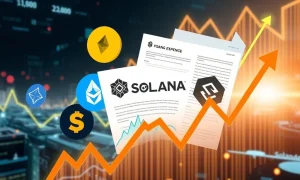The global financial landscape is undergoing a profound transformation. At its forefront, **stablecoin adoption** emerges as a powerful force. This digital innovation promises to reshape how money moves across borders. Circle Internet, a leading financial technology firm, actively champions this evolution. The company sees wider **stablecoin adoption** as key for both payments and foreign exchange. Indeed, their vision involves a future where digital currencies offer unparalleled efficiency. This article explores Circle’s strategic push. It details the benefits and implications of increased **stablecoin adoption** for businesses and individuals worldwide.
Understanding Stablecoins and Their Role in Global Finance
Stablecoins represent a unique class of cryptocurrency. Their value is pegged to a stable asset. This asset is typically a fiat currency, such as the US dollar. They can also be tied to commodities like gold. This peg provides crucial price stability. Consequently, stablecoins avoid the extreme volatility often associated with other cryptocurrencies like Bitcoin or Ethereum. This inherent stability makes them ideal for everyday transactions. It also makes them suitable for longer-term financial operations. For instance, USDC, Circle’s flagship stablecoin, maintains a 1:1 peg with the US dollar. Each USDC in circulation is backed by an equivalent amount of US dollar reserves. These reserves are held in segregated accounts. Furthermore, they are regularly audited by independent accounting firms. This robust backing ensures reliability. It also builds trust among users. Therefore, it is a critical factor for widespread **stablecoin adoption**. They bridge the gap between traditional finance and the innovative world of blockchain technology.
The Mechanics of Stablecoin Adoption in Payments
Stablecoins offer a compelling solution to many challenges in traditional payment systems. Conventional cross-border payments often involve numerous intermediaries. They also incur high fees and slow settlement times. For example, international bank transfers can take days to clear. This delay impacts cash flow for businesses. It also inconveniences individuals sending remittances. Conversely, stablecoins can facilitate near-instantaneous transfers. They leverage blockchain technology to bypass many of these intermediaries. This direct approach significantly reduces transaction costs. Moreover, it accelerates the speed of money movement. Consider a small business importing goods from another country. With stablecoins, they can settle invoices in minutes. This contrasts sharply with the multi-day wait times of traditional methods. This efficiency directly accelerates **stablecoin adoption** for global payments. It makes digital transactions more accessible and affordable for everyone.
Streamlining Global Payments with Stablecoins
The efficiency stablecoins bring to global payments is transformative. Businesses engaging in international trade benefit immensely. They can manage their cash flow more effectively. They also reduce exposure to currency fluctuations during transfer periods. Consumers likewise gain from cheaper and faster remittances. This is especially impactful for migrant workers supporting families abroad. Circle’s infrastructure supports these rapid, low-cost transactions. Their platform provides the necessary tools for businesses to integrate USDC into their payment flows. This includes APIs and direct connections to banking rails. Consequently, companies can easily send and receive payments in USDC. This simplifies international commerce. It further solidifies the case for increased **stablecoin adoption** across diverse industries. The benefits extend from large corporations to individual users, fostering a more connected financial world.
Stablecoins and the Foreign Exchange Market
The foreign exchange (FX) market is the world’s largest financial market. It operates 24/7. However, it still faces inefficiencies. These include high spreads, settlement risk, and limited operating hours for some transactions. Stablecoins introduce a new paradigm here. They offer a direct, digital bridge between different fiat currencies. For example, a multinational corporation might use USDC to convert dollars to euros digitally. This process avoids the complexities and delays of traditional FX. Traditional FX requires multiple bank accounts and correspondent banking relationships. Stablecoins simplify this significantly. They allow for instant liquidity and settlement. This reduces the need for pre-funding accounts in various currencies. Moreover, stablecoins can reduce counterparty risk. They also enhance liquidity for certain currency pairs. This contributes to broader **stablecoin adoption** in FX operations. It makes currency exchange more efficient and transparent.
Circle’s Strategic Imperatives for Stablecoin Adoption
Circle has positioned itself as a pivotal player in the stablecoin ecosystem. The company focuses heavily on regulatory compliance and transparency. They ensure USDC is fully reserved with high-quality liquid assets. This commitment builds trust among users and regulators alike. Circle actively collaborates with financial institutions worldwide. Their goal is to integrate USDC into existing financial infrastructures. This strategic approach directly drives **stablecoin adoption** on a global scale. They understand that trust is paramount for widespread acceptance. Furthermore, Circle engages with policymakers. They advocate for clear and supportive regulatory frameworks. This proactive stance helps to legitimize stablecoins. It also paves the way for their broader integration into mainstream finance. Their efforts are crucial for overcoming regulatory hurdles. Consequently, they accelerate the path to mass **stablecoin adoption**.
Benefits for Businesses and Consumers
The advantages of increased **stablecoin adoption** extend to various stakeholders. Both enterprises and individuals stand to gain significantly. Here are some key benefits:
- Reduced Transaction Costs: Stablecoins often incur lower fees compared to traditional banking services. This is especially true for international transfers. Businesses can save substantial amounts on transaction fees. Consumers also benefit from cheaper remittances.
- Faster Settlement Times: Transactions can settle in minutes, not days. This improves cash flow management for businesses. It also allows for real-time reconciliation. Consequently, it boosts operational efficiency.
- Enhanced Financial Inclusion: Stablecoins provide access to digital finance for the unbanked and underbanked populations. A smartphone and internet connection can be enough. This opens up new economic opportunities for millions globally.
- Increased Transparency: Blockchain technology offers an immutable record of transactions. This provides greater transparency and auditability. Businesses can track payments more easily. It also reduces fraud risks.
- Simplified Cross-Border Trade: Businesses can manage international payments more efficiently. This includes supplier payments, payroll for remote workers, and e-commerce settlements. Stablecoins remove many complexities of traditional international banking.
These benefits collectively make a strong case for integrating stablecoins into everyday financial operations. They offer a tangible improvement over legacy systems.
Overcoming Hurdles to Widespread Stablecoin Adoption
Despite the clear benefits, challenges remain. Regulatory clarity is still evolving in many jurisdictions. Different countries have varying approaches to digital assets. This creates a fragmented global landscape. Education also plays a vital role. Many potential users do not yet fully understand stablecoins. They may confuse them with volatile cryptocurrencies. Circle actively engages with policymakers globally. They advocate for clear, supportive regulations. Furthermore, they invest in educational initiatives. These efforts aim to demystify digital currencies. Consequently, they pave the way for more robust **stablecoin adoption**. Scalability of underlying blockchain networks is another consideration. However, ongoing technological advancements address this. Solutions like Layer 2 networks are improving transaction throughput. They are also reducing fees. Interoperability between different blockchain networks is also improving. This will further enhance the utility of stablecoins. It will also facilitate their seamless integration into various platforms. Overcoming these hurdles is crucial for accelerating the pace of **stablecoin adoption** worldwide.
The Future Trajectory of Stablecoin Adoption
Experts widely predict continued growth for stablecoins. Their integration into mainstream finance seems increasingly inevitable. Circle plans to expand its offerings and reach. They foresee a future where USDC becomes a global digital dollar. This would facilitate frictionless commerce worldwide. The intersection of traditional finance and digital assets will deepen. We may see stablecoins used for a wider array of financial services. This includes lending, borrowing, and even tokenized securities. Central Bank Digital Currencies (CBDCs) are also on the horizon. Stablecoins like USDC could potentially complement CBDCs. They could also serve as a bridge for private sector innovation. The long-term vision involves a truly global, digital financial system. Ultimately, **stablecoin adoption** could redefine global economic interactions. It promises a more connected, efficient, and inclusive financial system for everyone. Circle’s continued innovation will undoubtedly play a significant role in shaping this future.
Conclusion
In conclusion, Circle Internet stands at the forefront of a financial revolution. Their strategic focus on **stablecoin adoption** in payments and foreign exchange is transformative. Stablecoins offer unparalleled speed, efficiency, and lower costs. They address long-standing issues in global finance. This includes slow cross-border transfers and high transaction fees. While challenges persist, Circle’s commitment to regulation, transparency, and innovation is clear. Their efforts are building trust and paving the way for mass adoption. The widespread integration of stablecoins like USDC will likely redefine global commerce. This evolution promises a more accessible, efficient, and interconnected financial future. As the digital economy expands, stablecoins will undoubtedly play a pivotal role in shaping how value is exchanged globally.
Frequently Asked Questions (FAQs)
Q1: What is a stablecoin, and why is it important for payments?
A1: A stablecoin is a type of cryptocurrency. Its value is pegged to a stable asset. This asset is often a fiat currency, like the US dollar. This peg provides price stability. It makes stablecoins suitable for transactions. For payments, stablecoins offer speed, lower fees, and global accessibility. They avoid the volatility of other cryptocurrencies. This reliability is crucial for widespread use in commerce.
Q2: How does Circle Internet contribute to stablecoin adoption?
A2: Circle Internet is a leading issuer of USDC, a major regulated stablecoin. They build the underlying infrastructure for its use in payments and foreign exchange. Circle also actively works with regulators worldwide. This ensures compliance and builds trust. Their efforts aim to integrate stablecoins seamlessly into mainstream financial systems.
Q3: What are the main benefits of using stablecoins for cross-border transactions?
A3: Stablecoins offer several key benefits for cross-border transactions. These include significantly faster settlement times, often in minutes. They also provide lower transaction fees compared to traditional methods. Furthermore, they enable 24/7 global transfers. They enhance transparency through blockchain technology. This makes international trade more efficient and cost-effective.
Q4: Why are stablecoins important for the foreign exchange (FX) market?
A4: Stablecoins streamline foreign exchange operations. They allow for near-instant, direct currency conversions. This bypasses traditional banking intermediaries. They can reduce costs and enhance liquidity for certain currency pairs. This makes cross-border transactions more efficient. They also help reduce settlement risk and provide 24/7 access to currency markets.
Q5: Is USDC regulated, and why is this important for trust?
A5: Yes, USDC is a regulated stablecoin. Circle Internet ensures it is fully reserved. These reserves consist of high-quality liquid assets. Independent auditors regularly verify these reserves. This commitment to regulation builds user confidence. It also makes USDC acceptable to financial institutions and businesses. Regulatory oversight ensures stability and consumer protection.
Q6: What challenges hinder wider stablecoin adoption, and how is Circle addressing them?
A6: Key challenges include evolving regulatory frameworks across different jurisdictions. A lack of public understanding also plays a role. Scalability of underlying blockchain networks is another factor. Circle actively addresses these issues. They engage with policymakers to advocate for clear regulations. They also invest in educational initiatives. Furthermore, they support technological advancements to improve scalability and interoperability.








